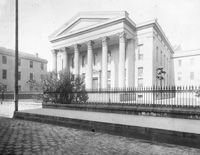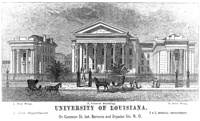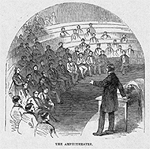|
The Founding
of Tulane University School of Medicine
In 1834, the Medical College
of Louisiana was founded by three American physicians new
to the city: Dr. Thomas Hunt, of South Carolina, Dr. Warren
Stone, of Vermont, and Dr. John Harrison, of Washington, D.C.
All three men were twenty-six years old or younger. The announcement
of the founding of the school created quite a stir among the
establishment French and Creole physicians. Three young Americans,
new to the city, had announced they would found a new medical
college with lectures entirely in English. In addition, Stone
and Hunt became house surgeons at Charity, shaping medical
practices during their tenure and giving more weight to the
commonly held impression of Americans “taking over”
medical education in the city.
The school opened in January
1835. The first lecture was delivered by Dr. Hunt in the Strangers
Unitarian Church thanks to the kindness of Parson Theodore
Clapp. Classes were taught in a variety of locations including
Charity Hospital, which was “open every day for the
attendance of the students.” The first course of study
ended in April 1835, to high acclaim. The first medical degrees
granted in the South were conferred in April of 1836 by Dean
Charles Luzenberg.
In 1840 a house was rented
next to Charity Hospital that allowed for all the medical
lectures to take place in one room. A prospectus from this
time brags a fact that has held true for all of Charity’s
history: “In the Surgical Department, the advantages
of this College rank those of all others in the Union. The
number of wounds, fractures, dislocations, and other injuries,
and disease requiring the frequent exercise of Operative Surgery,
admitted into the Wards of the New Orleans Hospital, will
be found on examination to exceed that of any other in America.”
 1843,
the relationship between the medical college and Charity was
cemented even further. In that year the college petitioned
the Louisiana Legislature to grant them land in order to build
a medical school building, with the provision that the faculty
would care for the patients of Charity free of charge for
ten years. Thus began the Tulane’s official involvement
with Charity Hospital. The tradition of providing attending
physicians to Charity free of charge continued into the 1960’s.
The request was granted, and the first permanent medical college
building was erected at a cost of $15,000. It contained a
lecture room, a chemical laboratory, a library and reading
room, a museum, an amphitheater, and a dissecting room on
the top floor. 1843,
the relationship between the medical college and Charity was
cemented even further. In that year the college petitioned
the Louisiana Legislature to grant them land in order to build
a medical school building, with the provision that the faculty
would care for the patients of Charity free of charge for
ten years. Thus began the Tulane’s official involvement
with Charity Hospital. The tradition of providing attending
physicians to Charity free of charge continued into the 1960’s.
The request was granted, and the first permanent medical college
building was erected at a cost of $15,000. It contained a
lecture room, a chemical laboratory, a library and reading
room, a museum, an amphitheater, and a dissecting room on
the top floor.
 In
1847, the Louisiana Legislature established the University
of Louisiana, and the Medical College of Louisiana was assumed
into the school, becoming the Medical Department of the University
of Louisiana. The reputation of the new medical school grew
quickly, and enrollment continued to accelerate over the years
leading up to the Civil War. In
1847, the Louisiana Legislature established the University
of Louisiana, and the Medical College of Louisiana was assumed
into the school, becoming the Medical Department of the University
of Louisiana. The reputation of the new medical school grew
quickly, and enrollment continued to accelerate over the years
leading up to the Civil War.
The faculty relations
of the young physicians in these early years were not without
tumult. Dr. Hunt, the first dean of the medical school, criticized
a newspaper editor named J. W. Frost in 1851 over a political
affair. Frost subsequently challenged Hunt to a duel, to which
he agreed. The men met south of the city and fired shotguns
at each other. Hunt’s second round wounded Frost in
his chest, and he died that day. The dean was never prosecuted.
In 1856 two Charity Hospital physicians entered into another
acrimonious debate. The argument surrounded a medical student
named Weems, who had been shot by a law student at a Mardi
Gras ball. Dr. Samuel Choppin, a surgeon at Charity and medical
school faculty member, had Weems sent to Charity for care.
While there, Weems was seen by Charity’s house surgeon,
Dr. John Foster. Foster, as house surgeon, had the right to
operate on Weems, and summarily ordered Choppin’s prescriptions
for the student discarded. Choppin and Foster had the misfortune
to meet at the dying Weem’s bedside while rounding that
day. They began to shout and had a “severe fist encounter,”
later dueling in the yard of Charity with shotguns. Luckily
both missed. Three years later, Foster and Choppin again quarreled
over rights to treat a patient, this time a man with a carotid
aneurysm. Foster eventually sought out Choppin. Their exchange,
described by Salvaggio, is informative:
“Are you looking
at me, sir?” asked Choppin, and Foster replied, “Yes,
sir, I am looking at you.” “And what do you think
of me?” continued Choppin. Foster responded, “I
think you are a God-damned scoundrel.” At that instant,
both physicians drew their pistols.
Foster shot Choppin through
the neck, shearing his jugular vein, and in the hip. Choppin
responded by charging Foster with a Bowie knife, at which
point medical students stormed both men and broke up the fight.
Choppin miraculously survived, and did not press charges against
his old rival.
 Charity
Hospital’s reputation continued to grow, mostly based
on the reputation of the medical college’s physicians.
A journalist from Harper’s Weekly wrote in 1859 of the
“commodiousness of its buildings … the superior
skill of its attending physicians, the admirable neatness
of its domestic appliances, and the impartial catholicity
of its administration…” Visitors marveled at the
sight of medical students witnessing surgery in the amphitheatre.
The Harper’s Weekly journalist described Dr. Stone,
“that veteran man of the knife” and one of the
founders of the medical college, as he performed an amputation
for medical students: “with cuffs thrown back, eye all
ablaze, and lips firmly clinched, he prepares to make the
adroit thrust… the sudden flash of polished steel; the
dull, muffled sound of the yielding flesh, the spirt of blood…
the sharp cry of the patient… these are the outlines
of a picture that thrills and terrifies the uninitiated beholder." Charity
Hospital’s reputation continued to grow, mostly based
on the reputation of the medical college’s physicians.
A journalist from Harper’s Weekly wrote in 1859 of the
“commodiousness of its buildings … the superior
skill of its attending physicians, the admirable neatness
of its domestic appliances, and the impartial catholicity
of its administration…” Visitors marveled at the
sight of medical students witnessing surgery in the amphitheatre.
The Harper’s Weekly journalist described Dr. Stone,
“that veteran man of the knife” and one of the
founders of the medical college, as he performed an amputation
for medical students: “with cuffs thrown back, eye all
ablaze, and lips firmly clinched, he prepares to make the
adroit thrust… the sudden flash of polished steel; the
dull, muffled sound of the yielding flesh, the spirt of blood…
the sharp cry of the patient… these are the outlines
of a picture that thrills and terrifies the uninitiated beholder."
Charity at this time
was probably the largest hospital in the world, with 1,000
beds, 200 more than the eminent Hotel Dieu in Paris.
prev | 1
| 2 | 3
| 4 | 5
| 6 | 7
| 8 | 9
| next |


